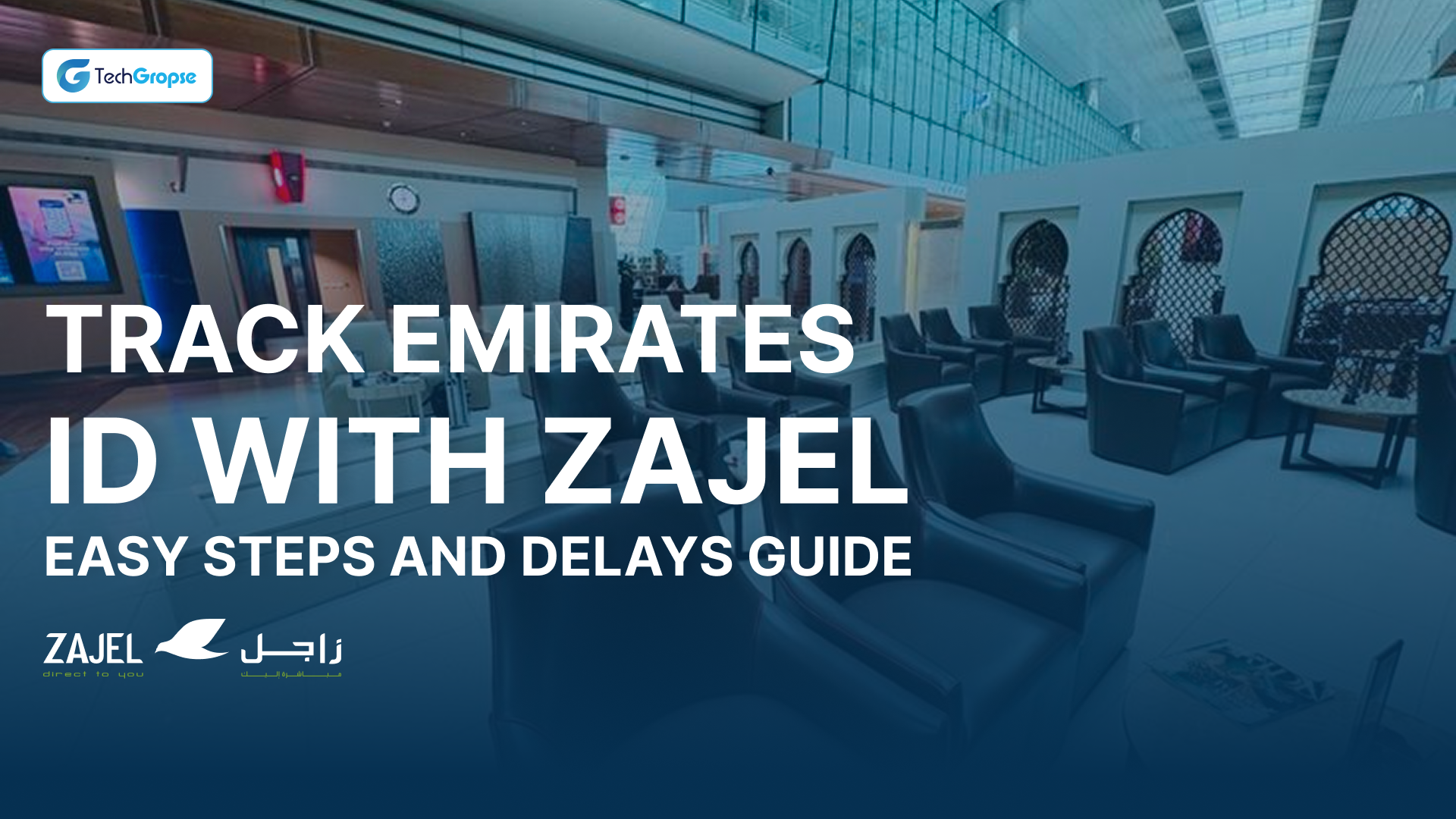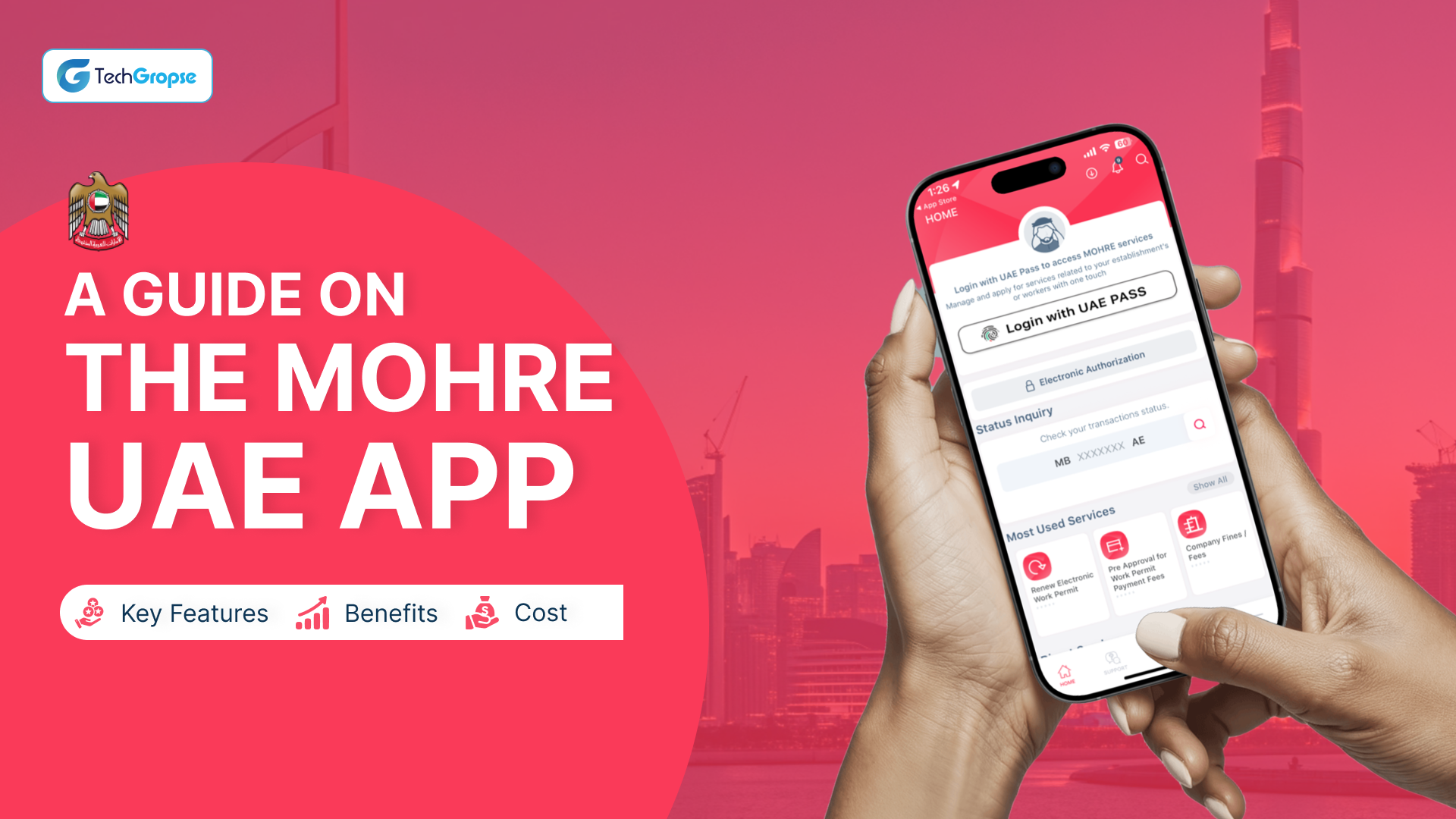Custom software development in Saudi Arabia is now experiencing a new phase in KSA’s digital transformation trajectory.
From logistics to retail, healthcare to government, Saudi businesses are now asking how fast and how smartly they can digitize their business processes. And this is where custom software development comes in. As local businesses scale, compete, and serve increasingly mobile, data-hungry, and expectation-rich users, the one-size-fits-all model starts to crack.
If you’re a fast-growing logistics company, a healthtech startup in Jeddah, or an enterprise that wants to revamp internal systems, custom software now works as a perfect future-ready growth engine for your business. Because in a country where transformation is moving faster than ever, the software you choose to build may define the business you become.
In this blog, we’ll unpack what custom software development company in Saudi Arabia actually involves in the Saudi Arabian context. How much it costs in 2025, what the development journey looks like, and most importantly, how it can unlock long-term ROI for businesses serious about leading. So let’s dive into.
Why Is The Demand for Custom Software Surging in Saudi Arabia?
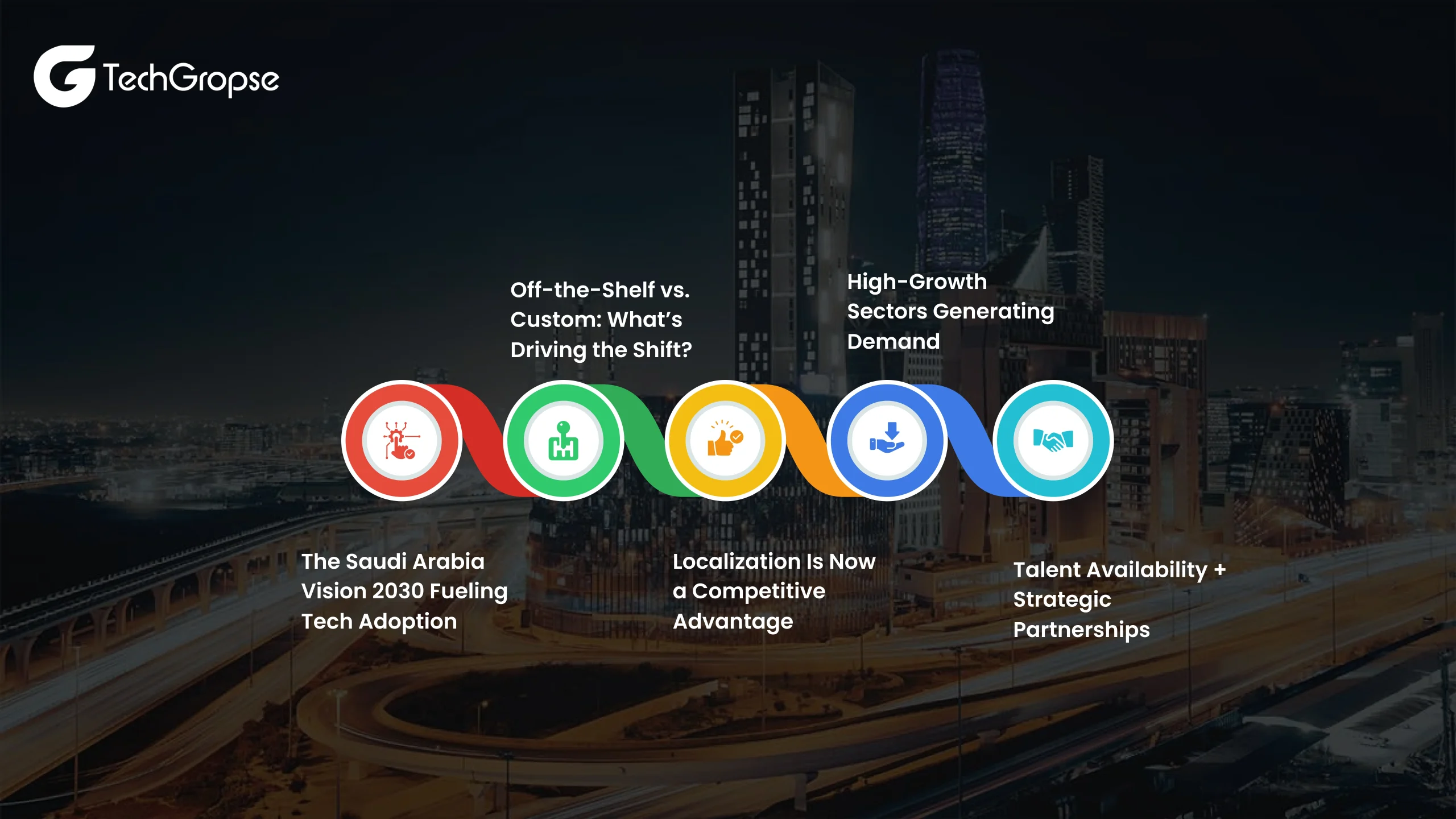
The demand for custom software development in Saudi Arabia is increasing with growing market penetration. Increasing adoption of digilization across industries, mobile app usage, smartphone and internet penetration are pushing the need for more personalized and specialized software and digital solutions.
If you look at the current market statistics you will find how significantly the market of custom software development in Saudi Arabia is expanding. According to a recent report by Grand View Research, the custom software development market in Saudi Arabia recorded a revenue of US$ 779.2 million in 2024. This is now estimated to reach US$ 2,406.1 million by 2030 at a CAGR of 20.4%.
(Source: Grand View Research)
So what are the reasons which are fueling the growth of custom software development in Saudi Arabia? Let’s discuss them below
1. The Saudi Arabia Vision 2030 Fueling Tech Adoption
Vision 2030 is both the compass and the catalyst for change. The Kingdom has chosen to work on modernizing every single socio-economic dimension from the ground up. Technology now sits on the throne as the architect of reforms in smart cities, e-governance, fintech, and digital health. Legacy software and packaged solutions often have almost inevitably become lagging behind local needs, compliance models, and expectations of the market.
Custom software solutions here allow government bodies, businesses, and SMEs to create digital products that adhere to the particular Saudi business logic, infrastructure, and user behavior. And it’s not something they are talking about in the future, major public and private sectors are already investing in custom software development in Saudi Arabia by 2025 to keep pace with change.
2. Off-the-Shelf vs. Custom: What’s Driving the Shift?
Saudi machines, especially those willing to leverage the growing digital push in the country, are turning their backs on white-label software solutions. Off-the-shelf or white-label solutions have speed and relatively low cost. Yet most of the time, they can’t accommodate the intricate, localized requirements of the Saudi market.
By their own nature, custom software grows with the business. They uphold data sovereignty and provide the scaling needs for a startup or an enterprise to innovate with confidence. Hence, this demand is driving a market shift from ready-made software solutions to custom software development in Saudi Arabia.
3. Localization Is Now a Competitive Advantage
Saudi consumers are heavily mobile-first, bilingual, and culturally nuanced. Off-the-shelf software rarely fits in such a mix. Custom software, on the other hand, can have RTL layouts, Arabic-first UX, region-specific payment gateways, and culturally-aware functionalities built into its very core. For ecommerce platforms, food delivery apps, or government portals, localization is a usability must. By embracing it in custom solutions, businesses often enjoy stronger engagement and better trust retention among Saudi users.
4. High-Growth Sectors Generating Demand
Sectors like healthcare, fintech, logistics, and retail in Saudi Arabia are digitizing faster than ever. Each one has a different set of regulatory requirements, data flows, integration, and performance needs. Off-the-shelf products can never fit these nuanced requirements. It’s custom software developed from scratch that satisfies immediate needs and yet retains the ability to evolve further with the business. That’s what growing businesses demand.
5. Talent Availability + Strategic Partnerships
Saudi Arabia is witnessing the rise of local and international pools of tech talent eager to serve this transformation. With development hubs nearby, GCC-wide collaboration, and Riyadh rising as a centre of tech innovation, businesses are probably never seen with so many strategic development partners.
This accessibility will minimize time-to-market and make custom development feasible, unlike say five years ago. With government grants, incubation support, and cross-border incentives thrown in, the business environment is more supporting of custom tech ideas than ever.
Also Read: Enterprise Software Development in Saudi Arabia: A Complete Industry Guide
Custom Software Development Process
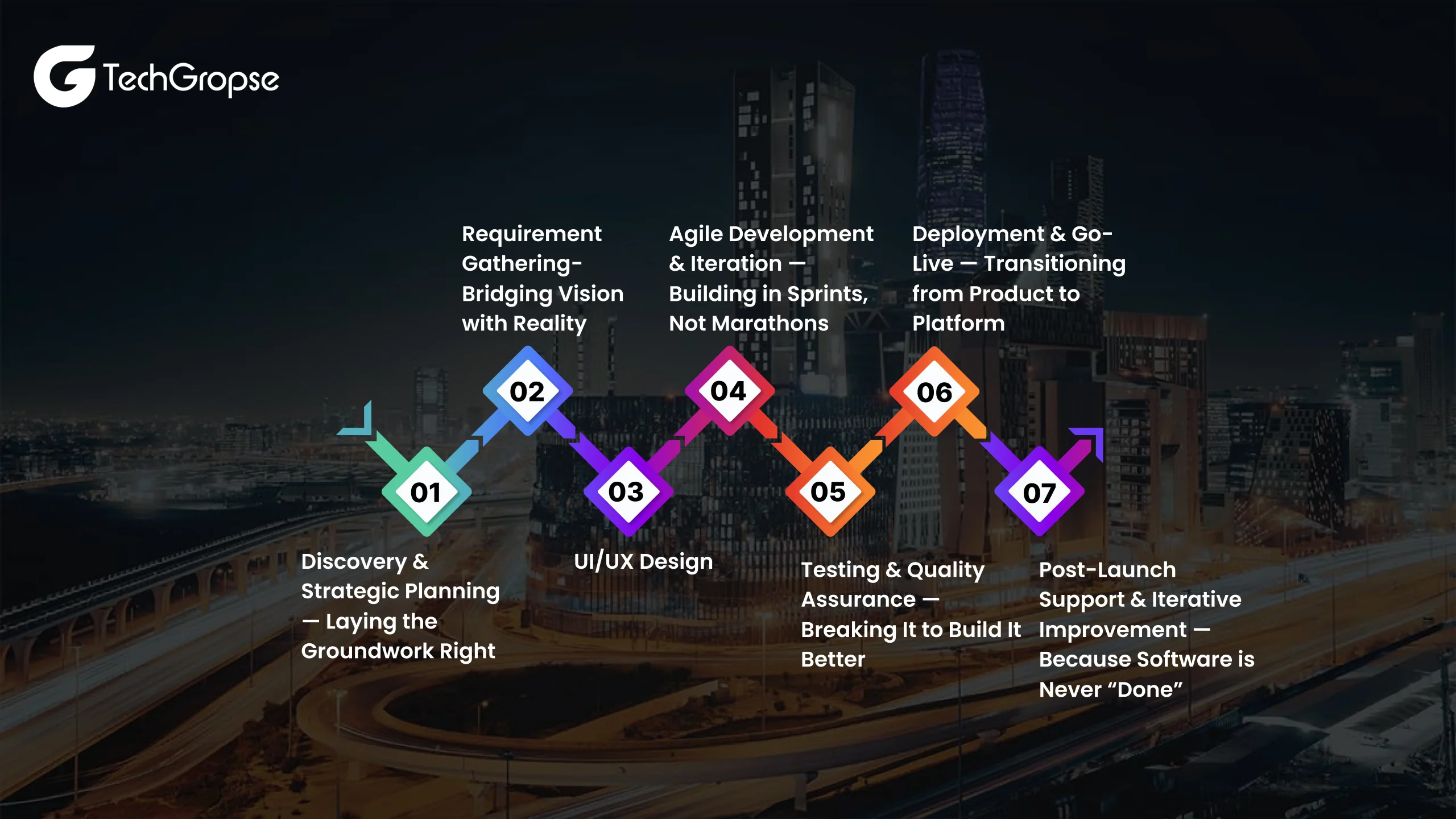
Now, here comes the technical part of your journey. Developing your custom software. Let’s see what steps does custom software development involve that you must be aware of.
Step 1: Discovery & Strategic Planning — Laying the Groundwork Right
Clarity is king here. Before a line of code is written, the process begins with understanding the business problem, user needs, and how the software fits into both its short-term goal and long-term vision. In the Kingdom of Saudi Arabia however, this step also includes local compliance mapping and ensuring that your software contains market-ready features.
Step 2: Requirement Gathering- Bridging Vision with Reality
Once the vision is set, conversion sets the vision into structured documentation. This includes user stories, performance expectations, data structures, and integration points. Based on the need, the perfect tech stack would be picked: Java backend if security is paramount; Node.js architecture for scalability; or Python engine if you want to make it AI-ready. It isn’t uncommon in Saudi projects to favor stack choices that support bilingual (Arabic-English) localization and strong cybersecurity.
Step 3: UI/UX Design
Design focuses on how the product works and feels in the digitally evolving yet distinct cultural milieu of Saudi Arabia. Designers produce wireframes and hi-fi prototypes that convey the user flow and evoke the right emotional response.
Culturally comfortable design (right-to-left alignment; modest imagery; support for the religious calendar) is key here. They iterate through real users’ and stakeholders’ feedback loops before heading to development. In essence, designing something felt by the user as native, intuitive, and inclusive to tap from the start.
Step 4: Agile Development & Iteration — Building in Sprints, Not Marathons
Once the designs are validated, development commences within the agile sprints. This is another integration layer for front-end, back-end, APIs, databases, and third-party services (such as payment gateways, SMS services, or AI engines).
Regular sprint reviews ensure the client stays informed and may provide opportunities for feedback and ad hoc adjustments. Most developer teams in Saudi Arabia will favor mobile-first and cloud-first design to accommodate their clientele, which is high on smartphone penetration and on-demand infrastructure preferences.
Step 5: Testing & Quality Assurance — Breaking It to Build It Better
QA comes in when modules are ready to put them under pressure testing. It is that stage where bug fixes occur and UX enhancements are made, ranging from functional testing, usability testing, performance, localization, and security audits.
In the Kingdom’s context, testing would go henceforth to toggle languages, compatibility settings to local payment processors (like STC Pay or Mada), and stress testing to cater for surges in user participation during National Day or Ramadan. So better fix it now rather than patch half-baked solutions after launch.
Step 6: Deployment & Go-Live — Transitioning from Product to Platform
After a rigorous round of testing, the software gets staged for deployment on either local servers or cloud platforms like AWS Saudi or Oracle Cloud Jeddah. Activities involve data migration, final UAT sign-off, and setting up of monitoring tools. Arabic content, metadata, and certifications will be prepared for app stores or web portals. Upon going live, end users start interacting with the system in real time and that is where they learn.
Step 7: Post-Launch Support & Iterative Improvement — Because Software is Never “Done”
Even after launch, the job isn’t over yet. Real feedback comes from real users, and analytics tell you what works and what doesn’t. Teams track how users are behaving, squash further bugs, and launch updates to coat features with wider adoption. In the rapidly evolving ecosystem of Saudi Arabia, long-term maintenance can even mean complying with regulatory changes, introducing AI features, or integrating new fintech or logistics APIs as a larger market starts to mature.
Learn More: AI-Powered Software Development Services in Saudi Arabia: The Future is Now
Cost of Developing Custom Software in Saudi Arabia
How much does custom software development cost? Well, there is no exact price tag to give since it totally depends on your project needs. Custom software development in Saudi Arabia is a strategic investment shaped by several on-ground realities.
For example, whether you hire a local developer or outsource your project to an offshore custom software development company. Saudi-based development teams come with the advantage of proximity, cultural alignment.
But they often command a higher cost due to talent scarcity and rising demand. On the other hand, outsourcing to global teams offers cost-efficiency. However, it can bring communication lags and challenges in complying with local norms.
Then comes the government regulation factor. Meeting these requirements often calls for specialist teams and adds cost layers most off-the-shelf software can’t account for. Lastly, tech stack decisions play a pivotal role in determining your custom software development cost. Scalable architectures may lean toward robust tech stacks like .NET Core, AWS-native solutions, or even AI-driven microservices. All of which influence both development complexity and price.
Hence, to estimate the cost of custom software development in Saudi Arabia you need to consider various factors in mind. Since we are a Saudi-based software development company we know what factors influence the cost. To give an overall idea below we have shared cost estimation for custom software development in Saudi Arabia for different categories that offer clarity on expected budgets based on project size and complexity:
Custom Software Development Cost in Saudi Arabia
| Project Size | Description | Estimated Cost (SAR) |
|---|---|---|
| Small Projects | Basic MVPs, landing pages, internal admin tools | SAR 30,000 – SAR 75,000 |
| Medium Projects | Mobile apps, mid-level CRMs, custom web apps | SAR 75,000 – SAR 200,000 |
| Large Projects | ERP systems, AI integrations, multi-platform ecosystems | SAR 200,000 – SAR 750,000+ |
Price Ranges by Project Type
| Project Type | Estimated Cost (SAR) |
|---|---|
| Web Application | SAR 40,000 – SAR 120,000 |
| Mobile Application | SAR 75,000 – SAR 250,000 |
| eCommerce Platform | SAR 100,000 – SAR 300,000 |
| ERP System | SAR 200,000 – SAR 600,000+ |
| AI-Powered Solution | SAR 250,000 – SAR 800,000+ |
| IoT-Based App | SAR 150,000 – SAR 500,000 |
| FinTech App | SAR 200,000 – SAR 700,000+ |
| Marketplace App | SAR 180,000 – SAR 600,000 |
| SaaS Product | SAR 150,000 – SAR 500,000+ |
Benefits of Custom Software Development
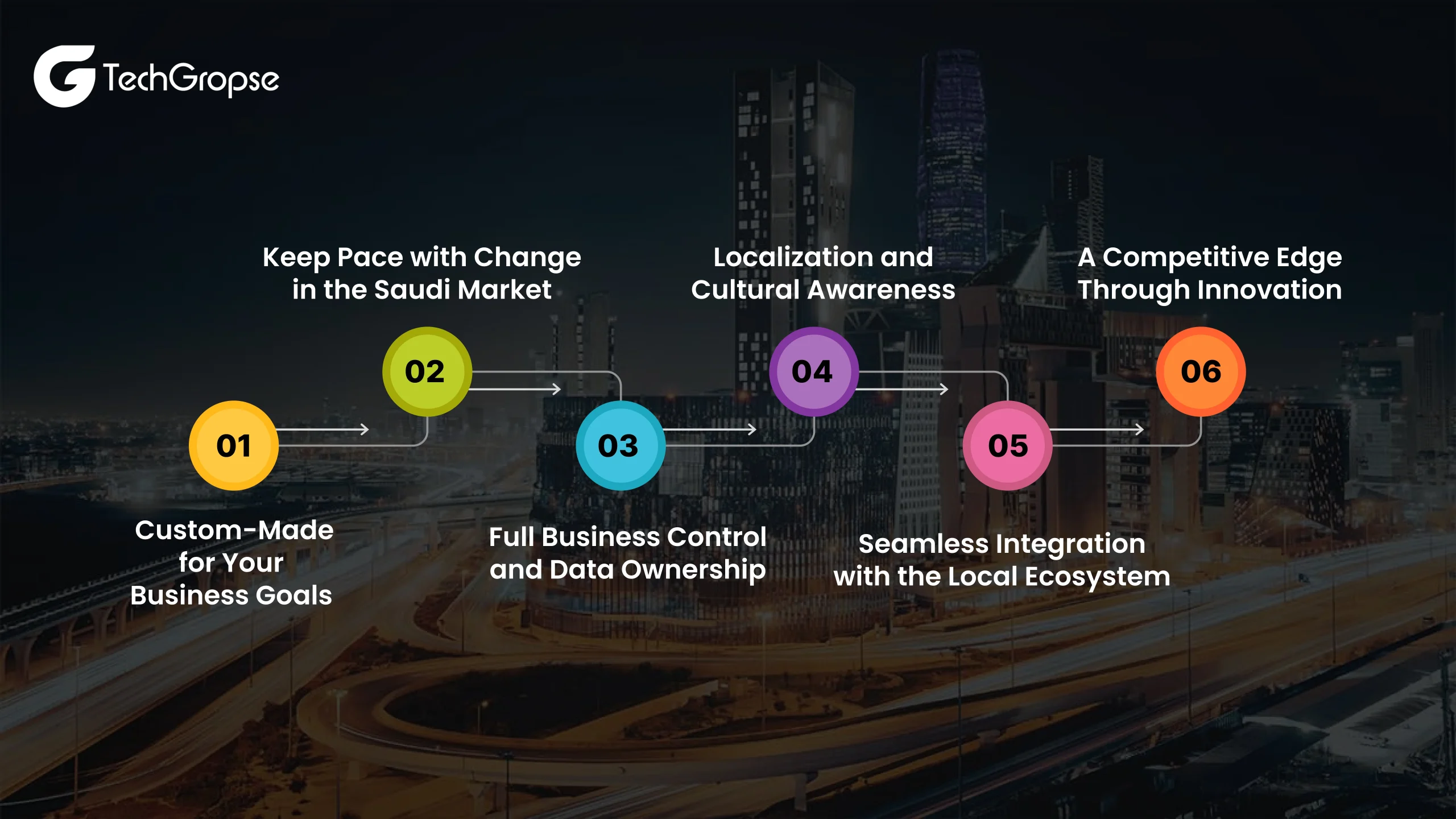
Now, let’s see why ultimately you should invest such a substantial amount in building custom software.
1. Custom-Made for Your Business Goals
Generic software might work for the short term, but it’s rarely aligned with your business DNA. Custom software is designed around your actual workflows, pain points, and market objectives.
For example, whether it is through logistics- software that maps the Riyadh supply chain grid, or a fintech startup looking for a Shariah-compliant automation: whichever way, custom software development gives you a solution that works the way you work.
2. Keep Pace with Change in the Saudi Market
Digital transformation and mobile app penetration go hand in hand in Saudi. Vision 2030 is causing waves in innovation across sectors like healthtech, edtech, and e-commerce. Custom-built solutions can scale to meet those changes. Off-the-shelf platforms? They tend to crack under pressure or charge an arm and a leg for growth.
3. Full Business Control and Data Ownership
Given increased regulations regarding sovereignty of data (like the NDMO), Saudi businesses simply cannot allow sensitive data to be stored on platforms which go ahead and ship it overseas. It’s meaning that custom software would keep your sensitive data exactly where you want to have it. Hosted on local cloud service or private servers compliant with such regulations, you decide who sees it, backs it up, or encrypts it. More convenience than that; such a program becomes a sort of assurance in such a data-driven economy.
4. Localization and Cultural Awareness
Saudi users expect their apps to speak both literally and culturally. With custom software, you can embed features like support for Hijri calendar, right-to-left navigation, and even advanced features aligned with Islamic practices. These would most well include Zakat calculations; prayer time-based scheduling is one of the fastest means of cultural fluency that drives acceptability and trust faster than any global templates.
5. Seamless Integration with the Local Ecosystem
Usually, off-the-shelf software will integrate with PayPal or Stripe and that’s about it. Custom-built platforms, on the other hand, are designed to integrate with the set of tools and platforms your users actually work with. The outcome: a snappy, delightful digital experience for end-users, and then higher technology retention among all users.
6. A Competitive Edge Through Innovation
In a region where sectors are opening up at a rapid clip, innovation pays. Custom software allows you to experiment with ideas and pilot niche models to get features in front of the market ahead of the competition. You are not restrained by a vendor’s roadmap. In fact, you are setting the pace of change. This is the difference between Saudi startups and corporations leaving the digital halls versus leading them.
Read Here: Ecommerce App Development Cost in Saudi Arabia 2025-Complete Edition
How to Choose The Right Partner for Custom Software Development in Saudi Arabia?
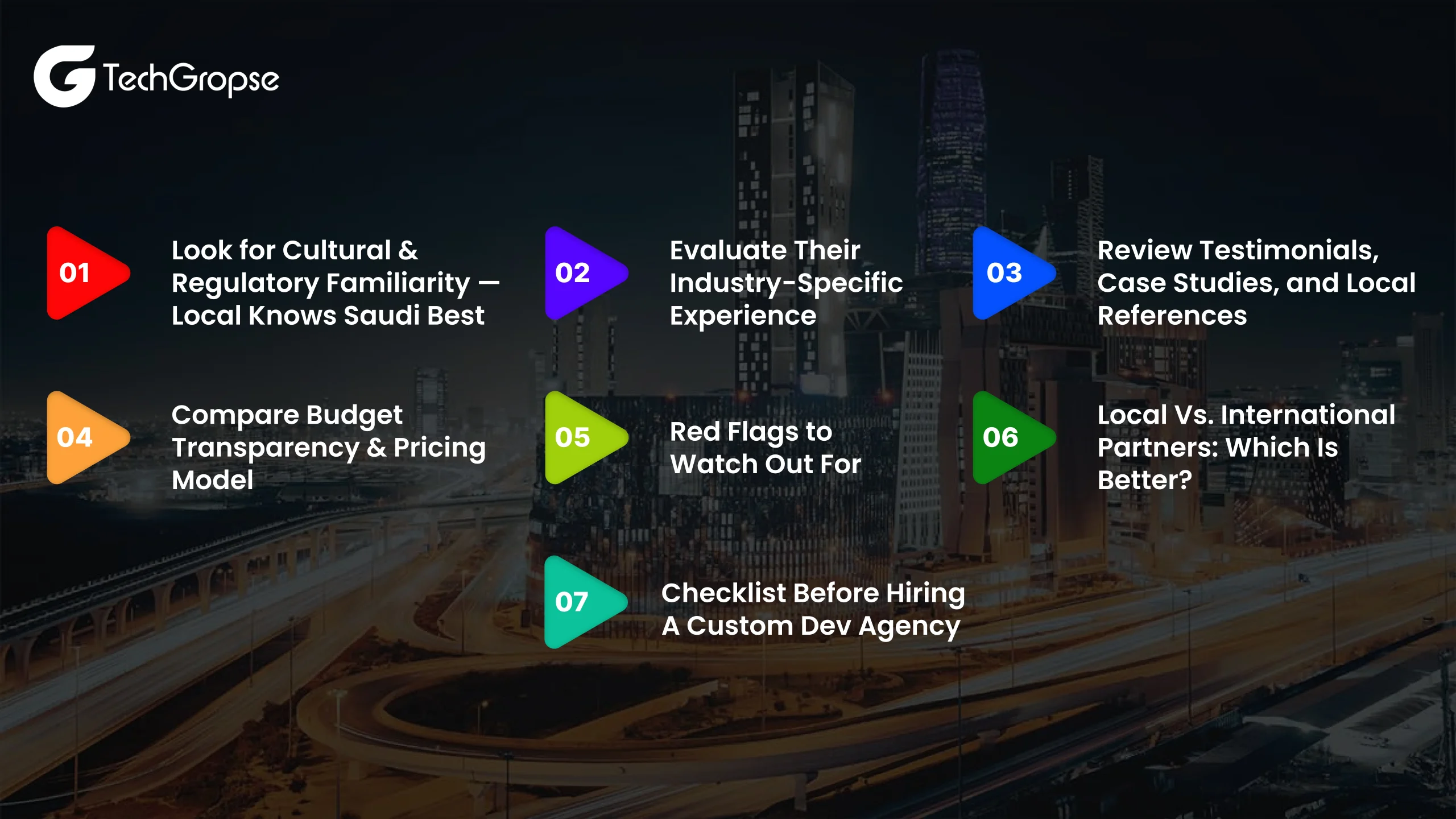
1. Look for Cultural & Regulatory Familiarity — Local Knows Saudi Best
Custom software development process also involves compliance, language, and cultural contexts. From knowing data localization laws from under Saudi’s National Data Management Office (NDMO), to respecting Islamic finance stipulations, your ideal custom software development company must know the Saudi market. Thus, you should try to hire a company experienced working with local businesses that understands Vision 2030.
2. Evaluate Their Industry-Specific Experience
A great custom software development company should have case studies or live projects in your industry. You want to ask them what similar work they have done and how they intend to integrate industry specifics they know into your solution (say, Mada, SADAD, Tawakkalna) and their capacity to scale the solution. An experienced team builds what your industry requires.
3. Review Testimonials, Case Studies, and Local References
Word of mouth, trust, and delivering precisely what is expected is still essential in Saudi business culture. It would be great if you asked for their clients’ genuine references, especially those from the Kingdom. Read through their case studies. Look at the UI/UX quality of apps they launched. Go ahead and talk to founders who have worked with them. Any reputable partner will happily put you in touch with some of their past clients because the results speak louder than their portfolio.
4. Compare Budget Transparency & Pricing Model
Custom software should be thought of as an investment. Nevertheless, your partner should provide transparency and not confusion. Request detailed estimates, timelines, and milestones. Do they charge per sprint? Per feature? A fixed price? Transparent companies explain what they charge for; they’ll steer clear of ambiguity. Within Saudi Arabia’s tech ecosystem, a cheap price should never come at the cost of transparency and suppliers finishing quality work.
5. Red Flags to Watch Out For
Selecting the wrong software development partner can lay waste to your entire digital strategy. Be suspicious of any vendors that can demonstrate no experience whatsoever in Arabic UX/UI design or who treat localization as an afterthought. Here in Saudi Arabia, right-to-left (RTL) interfaces, culturally conscious layouts, and Arabic-font-screen responsiveness are not optional; they are musts-and-gifted-to-you-ways-of-communication.
6. Local Vs. International Partners: Which Is Better?
Local Saudi companies will possess a more comprehensive knowledge of regulatory affairs, should have a native command of Arabic, and will avail the projects with boots-on-ground agility. They are best suited for highly compliant sectors or for government collaborations.
International development agencies will provide more extensive pools of technical talent, better turnaround time on bleeding-edge technical solutions such as AI/ML, and global UX best practices. Whichever way you take, ensure that your workplace is well aligned with Saudi business culture and users’ behaviour. It is becoming increasingly less about geography, more about collaboration intelligence.
7. Checklist Before Hiring A Custom Dev Agency
Before you make the commitment, make use of this checklist to sift promising partners from those who will let you down:
- Are you experienced with Arabic-first UX and RTL interfaces?
- What is your process for compliance with Saudi-specific regulations like NDMO, CITC, and SAMA?
- Do you have case studies of similar custom software projects that you worked on in the MENA region?
- How do you work with post-launch, version updates, and system scaling?
- What project management tools and communication cycles do you follow?
- Will I be assigned an individual point of contact for the entire development process?
- What is your view of Islamic finance APIs, regional payment gateways (Mada, SADAD), and Hijri calendar support?
Also Read: Custom vs White-Label App Development in Saudi Arabia: What’s Right for Your Business?
How TechGropse Helped a Saudi-Based Company Revamp Their Growth by Building a Custom CRM Software?
Being a leading custom software development company in Saudi Arabia we have proven experience of empowering businesses with tailor-made software solutions. One such real-life example is BarqTrade. A mid-sized B2B distribution firm dealing in electronics and home appliances, supplying over 400 retailers across the Kingdom. We enabled the company to scale up their growth by optimizing their business processes with a dedicated CRM software. Here is how we did it.
The Challenge: Disconnected Data, Missed Opportunities
The systems at BarqTrade worked in isolation from each other with respect to customers. Field agents manual reporting procedures, bills of lading errors happened quite often, and top management sightlessness on sales pipelines. What they needed was not just another generic CRM system but a platform that really spoke their own language and aligned with local workflows.
TechGropse’s Solution: Tailored CRM That Fits Like a Thobe
Rather than sealing away in an off-the-shelf solution, TechGropse made and developed a fully custom CRM tailored to cater to BarqTrade’s Arabic-first user-base, local legal compliance needs, and operational nuances. The major modules included:
- Arabic + English interface for cross-functional ease of use.
- Lead tracking featuring geo-tagging of mobile field agents.
- Automated invoicing and inventory sync with their internal ERP.
- Sales analytic dashboards bring performance insight to leadership.
- Role-based access control mapping to internal hierarchies.
It was, indeed, cloud-hosted, mobile-responsive, and more than capable of interfacing with their existing WhatsApp communication threads.
The Impact: From Manual Chaos to Measurable Momentum
- Just 90 days from deployment, BarqTrade started to report:
- 27% faster sales cycle due to live status updates of lead information;
- 40% lesser errors in reporting due to auto-sync of field data;
- Better decision-making with deep analytics on buying behaviour of customers;
- Higher employee satisfaction, especially from sales reps out in the field who no longer had to maintain daily Excel updates.
Conclusion
Custom software development promises to be ideal as Saudi Arabia embarks on Vision 2030’s ambitious digital transformation journey. White-label solutions might get you started but can rarely take you far. The custom-built solution sits with your workflows, your values, and market realities.
Yes, building custom software in Saudi Arabia requires thoughtful investing. But if done right, It future-proofs your business, gives you complete control over your data, and opens places to scale, speed, and agility. Contact with the right development Comapny in Saudi Arabia, you can build a business-transforming software for your business.
FAQs
In Saudi Arabia, custom software may start at a base price of SAR 75,000, whereas sterling platforms can go far beyond SAR 150,000 up to SAR 300,000. The parameters of price change depending on factors ranging from whether you are working with a local agency or an international team, using cutting-edge tech stacks, or integrating third-party APIs.
A typical minimal custom application will take an experience of any kind for 5-7 months. However, development time varies significantly depending on the scale of the application and hence the set of features to be implemented. On the contrary, large and feature-rich platforms such as CRM, marketplaces, and tools powered with AI take at least 6 months or even longer.
The custom software boom is being fueled by industries unable to delay in quick digitization. Those are retail (ecommerce & logistics), finance (Islamic fintech), healthtech, educational (e-learning) and public sector services.
Yes. Depending on your business model and digital maturity level, you may become eligible for incentives from the likes of Monsha’at, MCIT, or the Digital Government Authority. Startups focusing on Vision 2030 priorities—AI, IoT, or local cloud innovation—may get funds, mentoring, or expedited regulatory processes.
Not always “legally” required, but Arabic support is a must if your target clientele comprises citizens, public sector employees, or government institutions.
It depends on your money, timeline, and attitude toward cultural fit. Local developers or agencies in KSA are going to have far more in-depth knowledge of the regulatory landscape, language, and user behavior.
Again, international outsourcing is more cost-effective when you need backend-centric work. Today, many companies choose to go hybrid—keeping strategic planning local, while sending large-scale development offshore for trusted cost considerations.
Custom software is much more secure. While ready-made products are considered soft targets for hackers because of their wide usage, custom platforms can let you locally control the hosting, encryption of data, protocols for access, and when the patches for vulnerabilities are installed.



